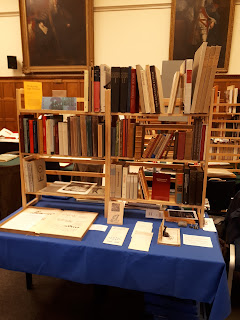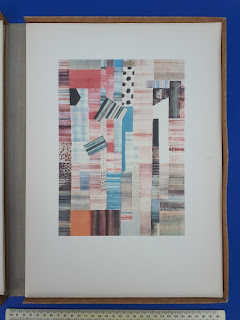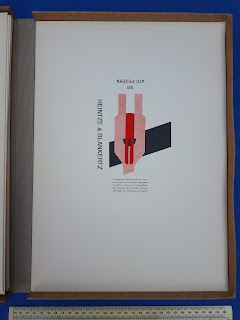A collection of books in German, mostly trade or book club editions, designed by Jan Tschichold, 1925-62. Includes 12 titles done for the socialist book club Der Bucherkreis, Berlin - about half of Tschichold's entire output for this organisation, one item with rare dustwrapper; also a full and representative showing of his work for Birkhauser, Basel. In all 36 vols, including two duplicates. Collected by the late Jerry Cinamon.
£450
References
L & W Jan Tschichold: Leben und Werk des Typographen, Verlag der Kunst, Dresden, 1977
NLS Jan Tschichold: Typographer
and Type Designer, National Library of Scotland, Edinburgh, 1982
Burke BURKE
(Christopher) Active Literature: Jan Tschichold and New Typography. Hyphen
Press, London 2007
1925
SCHAEFFER (Albrecht) Der Falke und die Wolfin. Dietrich
Reimer, Ernst Vohsen, Berlin, 1925. 650 copies. 4to. Pp. 61. Printed at the
Staatliche Akademie fur graphische Kunste und Buchgewerbe, Leipzig. Coloured
initials. Orig. paper-covered printed boards. Nice copy.
‘Die Initialen zeichnete J. Tschichold.’
L & W pl. 14; NLS 25, claiming binding design and
title-page also by JT.
1928
ROSS (Colin) Das Fahrten-und Abenteuerbuch. Buchergilde
Gutenberg, Berlin, 1928. Sm. 4to. 24 cm. Pp. 236. Orig. cloth.
‘Typographie und Einband: Ivan Tschichold.’
L & W pl. 63; Burke, pp.45-6 (1925 ed.).
1929
Insel-Almanach auf das Jahr 1929. Im Insel-Verlag zu Leipzig,
1929. 8vo. 19 cm. Pp. 208. Paperback.
‘Kalendarium und Umschlag zeichnete Jan Tschichold.’
L & W pl. 59; Burke p.199.
1930
DRECHSLER (Hermann) Aus der Werkstatt der Natur. Buchergilde
Gutenberg, Berlin, 1930. 8vo. 24 cm. Pp. 203. Orig. cloth.
‘Typographie und Einband: Jan Tschichold.’
L & W pl. 69.
FRANK (Josef Maria) Das Leben der Marie Szameitat. Roman. Der Bucherkreis, Berlin, 1930. 8vo. 19 cm. Pp. 332 + adverts. Orig. cloth.
‘Einband und Typographie: Jan Tschichold.’
Burke, p. 206.
NITTI (Francesco F.) Flucht. Die personlichen Erlebnisse eines politischen Gefangenen…Muller & I Kiepenheuer, Potsdam, n.d. [c.1930]. 8vo. 19 cm. Pp. 253. Orig. cloth, differentially faded and slightly worn at the extremities.
‘Einband und Schutzumschlag von Jan Tschichold.’
SCHERRET (Felix) Der Dollar Steigt. Inflationsroman aus einer alten Stadt. Der Bucherkreis, Berlin, 1930. 8vo. 19 cm. Pp. 232 + [5] (adverts). Orig. cloth.
‘Einbandentwurf: Jan Tschichold.’
Burke, p. 206.
VIDOCQS (Eugene-Francois) Vom Galeerenstrafling zum Polizeichef. Die seltsame Lebensgeschichte…vom ihm selbst erzahit. Der Bucherkreis, Berlin, 1930. 8vo. 19 cm. Pp. 280 + adverts. Orig. cloth. Recent clear film lamination.
‘Einbandentwurf und Typographie: Jan Tschichold.
1931
GOLDSTEIN (Arthur) Das lustige Buch des Bucherkreises. Eine
Sammlung von Humoresken und Grotesken. Der Bucherkreis, Berlin, 1931. 8vo.
19cm. Pp. 236 + adverts. Orig. brown cloth stamped in yellow.
‘Einbandentwurf und Typographie: Jan Tschichold.’
Burke, p. 206.
MANCHEN-HELFEN (Otto) Reise ins asiatische Tuwa. Mit 28 Photobildern. Der Bucherkreis, Berlin, 1931. SM. 4to. 24 cm. Pp. 172. Orig. qtr. cloth, printed boards. Edges of outer leaves spotted. Endpapers faded. Edges slightly worn.
‘Einbandentwurf und Typographie: Jan Tschichold.’
Burke, pp. 208-9.
TSCHETWERIKOV (Dmitrij) Die Rebellion des Ingenieurs Karinski. Verlag der Bucherkreis, Berlin, 1931. 8vo. 19 cm. Pp. 245 + adverts. Orig. cloth stamped in red.
‘Einbandentwurf und Typographie: Jan Tschichold, Munchen.’
Burke, p. 206.
GRISAR (Erich) Mit Kamera und Schreibmaschine durch Europa.
Bilder und Berichte. Verlag der Bucherkreis GmbH, Berlin, 1932. Sm. 4to. 24 cm.
Pp. 136 + [3] (adverts). Numerous black-and-white illusts. Orig. qtr. cloth,
pictorial boards. Edges somewhat worn but a sound copy.
‘Einbandentwurf, Satz- und Bildanordnung: Jan Tschichold.’
Burke, pp. 210-11.
KLAUS (Albert) Die Hungernden. Ein Arbeitslosenroman. Der Bucherkreis, Berlin, 1932. 8vo. 19 cm. Pp. 205 + adverts. Orig. cloth. Very worn but largely complete d.w.
‘Einbandentwurf und Typographie: Jan Tschichold.’
L & W pl. 67; Burke, p. 207.
NIKOLAJEWSKY (Boris) ASEW. Die Geschichte eines Verrats. Der Bucherkreis, Berlin, 1932. 8vo. 19 cm. Pp. 252 + adverts. Orig. cloth, differentially faded.
‘Einbandentwurf und Typographie: Jan Tschichold.’
SELINGER (Berta) Herz in Flammen. Roman. Verlag der Bucherkreis, Berlin, 1932. 8vo. 20 cm. Pp. 216 + [6] (adverts). Orig. cloth stamped in red. Lower cover damp-spotted.
‘Einbandentwurf und Typographie: Jan Tschichold.’
Burke, p. 207.
WICKEL (Helmut) I.- G. Deutschland. Ein Staat im Staate. Der Bucherkreis, Berlin, 1932. 8vo. 23 cm. Pp. 224. Orig. black cloth stamped in yellow. Spine faded.
‘Einbandentwurf und Typographie: Jan Tschichold.’
Burke, p. 213.
1933
ROSENFELD (Semjon) Russland vor dem Sturm. Aus dem Russischen
ubertragen von Werner Bergengruen. Der Bucherkreis, Berlin, 1933. 8vo. 19 cm.
Pp. 231 + adverts. Orig. cloth.
‘Einbandentwurf und Typographie: Jan Tschichold.’
Burke, p. 207.
1940
[Exhibition catalogue] Die Erfindung Gutenbergs. Ausstellung
im Gewerbemuseum Basel…vom 15. Dezember 1940 bis zum 16. Februar 1941. Benno
Schwabe, Basel, [1940]. 8vo. 23 cm. Pp. 84. Tipped-in plates. Later cloth. JT
lettered front wrapper bound in.
‘Die Schriftzeichnung fur den Umschlag von Jan Tschichold.’
Burke, p. 289.
1941
TSCHICHOLD (Jan) Geschichte der Schrift in Bildern. Holbein,
Basel, 1941. First edition. Sm. 4to. 26 cm. Pp. 72. Outer leaves spotted. Orig.
boards, d.w.
‘Satzanordnung, Einband und Schutzumschlag: Jan Tschichold.’
NLS 93; Burke, p. 288.
1942
FORCART-RESPINGER (E.) Basel und das Seidenband. Birkhauser,
Basel, 1942. Sm. 4to. 26 cm. Pp. 127. Colour costume plates. Fine monochrome
illusts. Orig. boards. Slightly frayed d.w.
?
KOELNER (Paul) Basler Zunfttherrlichkeit. Ein Bilderbuch der Zunfte und Gesellschaften. Birkhauser, Basel, 1942. 8vo. 25 cm. Pp. 240. Plates, some in colour. Orig. qtr. cloth, boards. D.w.
‘Buchhausstattung: Jan Tschichold.’
KOELNER (Paul) Basler Zunftherrlichkeit. Ein Bilderbuch der Zunfte und Gesellschaften. Birkhauser, Basel, 1942. 8vo. 25 cm. Pp. 240. Orig. qtr. cloth, printed boards. Slightly frayed d.w.
‘Buchausstattlung: Jan Tschichold.’
TSCHICHOLD (Jan) Schriftkunde, Schreibubungen und Skizzierin fur Setzer. Benno Schwabe, Basel, 1942. First edition. 8vo. Pp. 79. Orig. boards.
Burke p. 195
1944
ERASMUS Von Rotterdam, Das Lob der Torheit. Birkhauser, Basel,
1944. Sm. 8vo. 17 cm. Pp. 214. Orig. cloth.
‘Satzanordnung und Einbandwentwurf von Jan Tschichold.’
L & W pl. 99, 100; NLS 148.
‘Satzanordnung von Jan Tschichold.’
L & W pl. 93; NLS 147.
1945
FIELDING (Henry) Das Leben des Mr. Jonathan Wild, des Grossen.
Verlag Birkhauser, Basel, 1945. Sm. 8vo. 18 cm. Pp. 335. Orig. cloth. Slightly
frayed d.w. Sammlung Birkhauser vol. 8.
NLS 157.
Hafis. Eine Sammlung persischer Gedichte. Birkhauser, Basel, 1945. Sm. 8vo. 17 cm. Pp. 219. Orig. semi-stiff boards. D.w. (slightly worn). Sammlung Birkhauser vol. 7.
‘Herausgegeben und durchgesehen von Jan Tschichold.’
L & W pl. 97.
1946
KOELNER (Paul) Die Feuerschutzen-Gesellschaft zu Basel. Birkhauser,
Basel, 1946. Sm. 4to. 26 cm. Pp. 383. Tipped-in colour plates. Illusts. Orig.
cloth.
‘Besondern Dank…Jan Tschichold fur die Uberwachung der
Buchausstattung.’
SILENS (Constantin) Irrweg und Umkehr. Betrachtungen uber das Schicksal Deutschlands. Birkhauser, Basel, 1946. 8vo. 22 cm. Pp. 328. Orig. printed boards, d.w.
L & W pl. 102; NLS 151.
1947
MORE (Thomas) Utopia. Birkhauser, Basel, 1947. Sm. 8vo. 17 cm.
Pp. 205. Orig. semi-stiff boards. D.w. (slightly worn). Sammlung Birkhauser
vol. 11.
‘Satzanordnung von Jan Tschichold.’
NLS 158.
1951
TSCHICHOLD (Jan) Schriftkunde, Schreibubungen und Skizzierin
fur Setzer. [2nd ed.] Tempelhof, Berlin, 1951. 8vo. Pp. 79. Orig.
qtr. cloth, blind-stamped boards. Slightly worn d.w.
L & W pl. 133; NLS 102.
1952
WIELAND (Christoph Martin) Geschichte des Prinzen Biribinker.
Birkhauser, Basel. 1952. 500 copies. This 228, 238/250. Sm. 8vo. 17 cm. Pp.
154. Colour illusts. Pink silk boards. Card slipcase. Two copies.
‘Buchgrosse, Satz und Einband wurden Jan Tschichold
entworfen.’
NLS 168.
1954
STERNE (Laurence) Yoricks empfindsame Reise durch Frankreich
und Italien. Birkhauser, Basel, 1954. Sm. 8vo. 16 cm. Pp. 281. Orig. decorative
boards, d.w. Basler Drucke, vol. 4. 850 numbered copies.
‘Buchgrosse, Satz und Einband wurden von Jan Tschichold
entworfen.’
L & W pl. 89; NLS 170.
1957
Schonste liebe mich. Deutsche Liebesgedichte aus dem Barock
und dem Rokoko. Lambert Schneider, Heidelberg, 1957. Sm. 8vo. 17 cm. Pp. 94.
Eight colour plates of lace valentines. Orig. boards.
Edited and designed by Tschichold.
NLS 122.
1962
TSCHICHOLD (Jan) Willkurfreie Massverhaltnisse der Buchseite
und des Satzspiegels. Uberreicht von der Papierhandelsgesellschaft Bucherer,
Kurrus & Co., Basel, 1962. 8vo. 22 cm. Pp. 32. 1600 copies for private
distribution. Wrappers. Sewn.
L & W pl. 150; NLS 110.
1971
VON SICHOWSKY (Richard) & Hermann TIEMANN, Eds.
Typographie und Bibliophilie. Aufsatze und Vortrage uber die Kunst des Buchdrucks
aus zwei Jahrhunderten. Maximilian-Gesellschaft, Hamburg, 1971. 4to. 27 cm. Pp.
272. Orig. printed boards. Signed presentation inscription from Jan Tschichold
to John Dreyfus.
JT advised on the choice of texts.












































